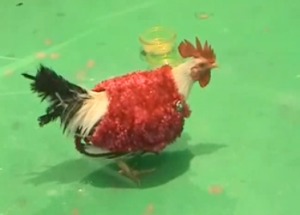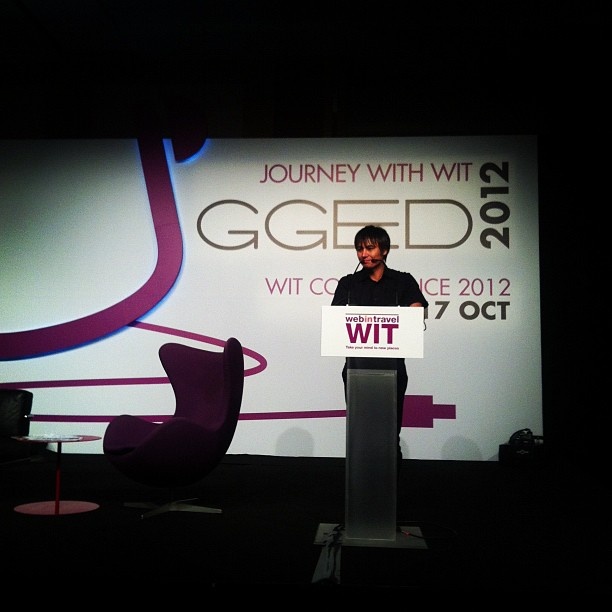Playful Fashion Communication Media
Playful Fashion Communication Media @Interaction 13_Yongsoon Choi
My Ph.D student explains his research.
Playful Fashion Communication Media @Interaction 13_Yongsoon Choi
My Ph.D student explains his research.
Many years ago I started a project called “Poultry.Internet”. A young and bright engineering student who was named James Teh came to my lab and asked if he could join my project. I had a hunch he was smart and talented and more importantly had a real interest and passion. I was right. He not only did a great job on Poultry Internet, he continued on to be my Ph.D. Student and worked on research on internet touch, and a project which extended from Poultry Internet for parent and children hugging called Huggy Pajama. Years later I am very happy and proud of James, not only did he finish his Ph.D but he turned his idea into a real product called T.Ware with the first aim to make hugging devices for autism affected children. Please check out his company and I wish it can be a great success!
BlackBerry from DOCOMO
Call for Chapters: Hyperconnectivity and the Future of Internet Communication
Proposals Submission Deadline: December 15, 2012
Full Chapters Due: March 15, 2013
Introduction
Over the past few decades, there has been a revolution in computing and communication. Machines that once occupied whole rooms have moved to the desktop, the lap and palm, and into clothing itself. Stand-alone systems are now networked with each other and a wide range of different devices across vast distances. For the first time in human history, we have become instantly globally connected, leading to a hyperconnected society and a 168 (24×7) world.
One of the consequences of this revolution is an explosion in interactive internet media technologies. Interactive media is one of the main developments that emerged as a product of the technological, intellectual, and cultural innovations of the late 20th century. Interactive media means much more than the convergence of telecommunications, traditional media, and computing. Using Marshall McLuhans definition of media as an extension of man, new media includes all the various forms in which we as humans can extend our senses and brains into the world. It includes new technologies that allow us to facilitate these new communications and create natural and humanistic methods of interfacing with machines, as well as other people, remotely over large distances using the full range of human gestures such as touch, sight, sound, and even smell. Thus, new media includes new ways of communication between people, between cultures and races, between humans and machines, and between machines and machines. The vision of new media is that it will bring about radical developments in every aspect of human life in the form of new kinds of symbioses between humans and computers, new ways of communication between people, and new forms of social organization and interaction. New research and products in internet communication will bring a new sense of presence of humans in the real and virtual worlds. Although there are many books related to internet technologies, the aspect of communication with all human senses in a constant hyperconnected manner still requires much scholarly research. This book will be at the forefront of scholarship in multisensory hyperconnected human communication and be of great resource to scholars and experts.
Objective of the Book
This book will examine and expose future internet communication technologies and telexistence paradigms to allow a hyperconnected presence of all our five senses, as well as non-verbal and emotional communication, through digital networks and the physical world of humans and devices/gadgets. It will examine the human communication habits and preferences in the internet age and the possibilities of new media being truly extensions of man. Researchers need to go beyond this approach and focus on human emotions and nonverbal language as key components in the communication process. Case studies will examine corresponding new forms of communication, culture, economy and business, healthcare, learning, and play.
Target Audience
In order for businesses and countries to flourish commercially and culturally in the new millennium, it is necessary for them to understand and foster the growth of interactive media technologies and open-minded creative experimentations. This book will provide new perspectives on the field of internet media for communication, learning, and entertainment. The potential audience of this book will be scientists, engineers, and researchers of internet and digital media communications. In addition, the proposed book will aid the prospective audience, e.g. university lecturers and professors, students, researchers, and developers of internet technologies. It will allow a fundamental understanding of hyperconnectivity with all human senses, and will provide a great resource for scholarship as well as internet application development.
Recommended topics include, but are not limited to the following:
Future internet communication technologies concerning multisensory and hyperconnected human communications. The chapter topics may include sub-topics related to:
*Affective Computing? Augmented, Mixed, and Virtual Reality
*Avatars and Autonomous Characters
*Cultural Computing
*Digital Broadcasting/Podcasting
*Educational
*Emerging World
*Entertainment
*Interaction and Experience Design
*Funology
*Game Design, Programming, and Production
*Human-Robot Interaction
*Children-Computer Interaction
*Location-Based Interaction
*Mobile and Ubiquitous Computing
*Persuasive Computing
*Smart Gadgets and Toys
*Social Networks
*Tangible Interfaces
*Urban Communities
*Visual Arts
Submission Procedure
Researchers and practitioners are invited to submit on or before December 15, 2012, a 2-3 page chapter proposal clearly explaining the mission and concerns of his or her proposed chapter. Authors of accepted proposals will be notified by December 30, 2012 about the status of their proposals and sent chapter guidelines. Full chapters are expected to be submitted by March 15, 2013. All submitted chapters will be reviewed on a double-blind review basis. Contributors may also be requested to serve as reviewers for this project.
Publisher
This book is scheduled to be published by IGI Global (formerly Idea Group Inc.), publisher of the “Information Science Reference” (formerly Idea Group Reference), “Medical Information Science Reference,” “Business Science Reference,” and “Engineering Science Reference” imprints. For additional information regarding the publisher, please visit www.igi-global.com. This book is anticipated to be released in early 2014.
Important Dates
December 15, 2012: Proposal Submission Deadline
December 30, 2012: Notification of Acceptance
March 15, 2013: Full Chapter Submission
April 30, 2013: Review Results Returned
June 30, 2013: Final Chapter Submission
Editors
Adrian David Cheok (Keio University, Tokyo, Japan)
Inquiries and submissions can be forwarded electronically (Word document):
Adrian David Cheok
Keio University
adriancheok@kmd.keio.ac.jp
www.adriancheok.info


Slashdot How To Hug a Chicken Via the Internet
How to hug a chicken, taste bitterness via the Internet | SmartPlanet
Electrical engineer Adrian Cheok is the first person to hug a chicken via the Internet. And now he’s building gear to transmit touch and taste – helping us hug kids and taste flavors from afar. IEEE Spectrum reports.
While at National University of Singapore, his 2005 Poultry Internet project showcased his fascination of transmitting not just multimedia but also sensations over the Internet. Starting with haptics, the technology of touch, he built a system that would let pet owners send their animals a pat from their office.
First, he built haptic jackets for the chickens, embedding them with vibrating elements.
The chicken’s jacket was connected wirelessly to the Internet, and its coop was rigged with a webcam. Then, in his office, Cheok patted a chicken doll that had touch-sensitive sensors, and the squeeze was transmitted to the live bird while he watched. The chicken had been hugged.
A 2007 project – the Huggy Pajama – allowed faraway parents to give their kid a remote good-night hug by just by pressing buttons.
Right now, he’s working on a commercial product that would let a user send a squeeze (and a warm a sentiment) to the ring on someone else’s finger. A prototype could be ready by the start of 2013.
He’s also working on a digital lollipop that can electrically and thermally stimulate the tongue to produce basic flavors like bitter, sour, salty, or sweet .
Cheok thinks multisensory communication gadgets will usher in the next stage of the Internet. “I believe we need to move from the age of information, which we have reached today, into the age of experience,” he says.
 “The ultimate Internet,” he adds, “will integrate all our senses.”
“The ultimate Internet,” he adds, “will integrate all our senses.”
Now at Now at Keio University’s Graduate School of Media Design, Cheok’s nurturing the next generation of creative innovators.
[Via IEEE Spectrum]Image: Adrian Cheok

Janet Fang is a contributing editor for SmartPlanet.
“I believe we need to move from the age of information, which we have reached today, into the age of experience,” he says. A 2007 project extended the chicken research to children: The Huggy Pajama allows faraway parents to give their kid a remote good-night hug by pressing an input module’s buttons. In user surveys, parents and children reported higher levels of emotional engagement thanks to the huggy system. Now Cheok’s working on a commercial product that would let a user send a squeeze—and a warm thought—to the ring on a loved one’s finger. He hopes to have a prototype ready by the start of 2013.
Haptics are just the beginning. Cheok has a “digital lollipop” in the works that electrically and thermally stimulates the tongue to produce basic flavors—bitter, sour, salty, sweet. He dreams of a system that would let friends in Paris send you a taste of their wine over the Internet. “The ultimate Internet,” he says, “will integrate all our senses.”
THack @ WIT Singapore – high commended, gamification, creativity and more | Tnooz
Adrian David Cheok was a judge at the THack start up competition contest.
“What can a single developer pull together with a handful of APIs, a creative mind and a touch of tongue-in-cheek?”

Prof Adrian David Cheok kicking off the future of content. The world today: new humans who are constantly communicating, accelerated change, also means skills get rapidly obsolete too. Tinker to survive in this world of change. Move from information communication to experiential communication. Mixed Reality. Touch, squeeze, taste transmitted through Internet. Taste and smell transceiver communications. Future travel, world of virtual reality. – @webintravel- #webstagram
Source: web.stagram.com via Adrian on Pinterest